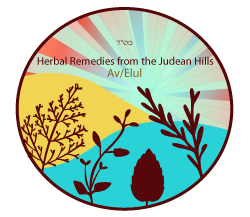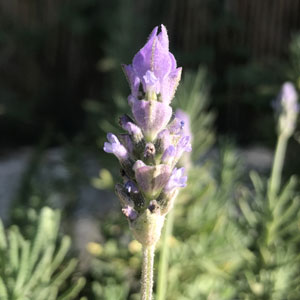(אֲזוֹבְיוֹן רְפוּאִי (לָבֶנְדֶר – Lavender – Lavandula Angustifolia
Printable Version
Soothing, Relaxing, Mood-lifting Lavender
On the right side of the walkway to our home, three lavender plants emanate their sweet fragrance as I walk by. Every Motzei Shabbat my husband picks a spike or two, which we use together with lemon geranium and myrtle for havdalah. Afterward, I put the fragrant herbs in a vase, which graces the guest bathroom sink. Lavender makes me reminisce about my dear grandmother ob”m. Her gorgeous garden was replete with fragrant flowers, and I recall how she once told me to plant many lavender plants to enjoy their beautiful fragrance when you walked by. It is a hardy perennial that survives harsh Gush Etzion winters. Lavender seems to bring back memories in general, although the conclusions of scientific studies regarding lavender’s effect on short-term memory are contradictory. When it comes to lavender’s calming effect, everyone agrees that lavender is calming and soothing. Lavender relaxes your mind and body. Lavender essential oil is often used to promote rest, bring on sleep and a feeling of happiness. If you suffer from insomnia, try sprinkling a few drops of lavender essential oil on your pillow before going to sleep. I always look forward to the final relaxation at the end of our weekly Meditative Movement (Yoga) class, when our teacher places an eye-pillow saturated with lavender essential oils on our eyes and forehead. As I breathe in the relaxing fragrance, after a long day of hard work, I may drift off a bit during the guided meditation.
Is Lavender Mentioned in the Torah?
Lavender is native to the Mediterranean, where the winters are cool and moist and the summers are hot and dry. Therefore, it is hard to believe that this lovely aromatic plant would not be mentioned in the Torah. Perhaps, the Biblical נֵרְדְּ/nerd could be referring to lavender? This herb is one of the 11 aromatics of the Ketoret (Temple incense), (Babylonian Talmud, Kritut 6a). According to Arizal, נֵרְדְּ/nerd corresponds to the sefirah of Tiferet – beauty (Sha’ar Hakavanot, Drushei Tefilat Hashachar 3). It exudes a beautiful fragrance, fit for a king, as we learn from Song of Songs:
ספר שיר השירים פרק א פסוק יב עַד שֶׁהַמֶּלֶךְ בִּמְסִבּוֹ נִרְדִּי נָתַן רֵיחוֹ:
“While the king sat at his table, my spikenard sent forth its fragrance” (Song of Songs 1:12).
ספר שיר השירים פרק ד פסוק יג שְׁלָחַיִךְ פַּרְדֵּס רִמּוֹנִים עִם פְּרִי מְגָדִים כְּפָרִים עִם נְרָדִים: (יד) נֵרְדְּ וְכַרְכֹּם קָנֶה וְקִנָּמוֹן עִם כָּל עֲצֵי לְבוֹנָה מֹר וַאֲהָלוֹת עִם כָּל רָאשֵׁי בְשָׂמִים:
“Your shoots are an orchard of pomegranates, with precious fruits; henna with spikenard plants. (14) Spikenard and saffron, calamus and cinnamon, with all trees of frankincense; myrrh and aloes, with all the chief spices (Song of Songs 4:13-14).
The Spiky Nard Confusion
The Torah commentaries or translations do not identify נֵרְדְּ/nerd with lavender, but rather with spikenard. There are various species of lavender, and spike lavender (Lavandula Latifolia) may be confused with spikenard. It is a small, aromatic herb or shrub; belonging to the Lamiaceae plant family and is closely related to true lavender (Lavandula Angustifolia). However, spikenard (Nardostachys Jatamansi) is a flowering plant of the Valerian family that grows in the Himalayas of Nepal, China and India. It was the more valuable of the two because it had to be imported from a great distance. It is distinguished by its many hairy spikes shooting out from one root. Spikenard is used as an aromatic ingredient in perfumes due to its sweet and earthy scent. In Ayurvedic medicine, it is famous for its cognitive and neurological benefits. Although lavender and spikenard are two completely unrelated herbs, they both have a calming effect that facilitate sound sleep. Interestingly, the Hebrew word ‘nerd’ from the root נ-ר-ד/nun-reish-dalet also means to fall asleep. The lavender shrub is named from the Latin ‘lavare,’ to wash because the ancient Romans used lavender in their bath water as a perfume as well as for its therapeutic properties. The Greeks called lavender ‘nardus,’ referring to a city in Syria called ‘Naarda,’ where lavender was often sold. Many simply called the plant ‘nard.’ This explains why some people confused the Biblical נֵרְדְּ/nerd with lavender.
The Lavender Cleanse Connection
Lavender has been used for over 2,500 years, starting with the ancient Egyptians who used it in their mummification process and as a perfume. It was also popular among Arabs, Romans and Greeks. In the North of England, during the middle ages, washerwomen were called ‘Lavenders’ due to the custom of scenting newly washed linen with lavender, to keep them moth and insect-free. Adding a few drops on a cotton cloth in the dryer will help repel insects and prevent moths. You can also make an all-purpose cleaner with a few drops of lavender essential oil, white vinegar and baking soda. For personal purification, soak in a lavender bath (with five to seven drops of lavender oil) for twenty to thirty minutes. A few drops of lavender with witch hazel is a great facial cleanser. You may also use lavender to help ‘wash’ away negative energies. Turner, in his work, A New Herball from the mid-1500s, explains that the name ‘lavender’ originated from the word ‘lavare’ because it would cleanse the head and mind. Perhaps he was referring to lavender’s ability to alleviate migraine headaches, or for treating mental disease. In either case, I recommend using a drop of lavender in a carrier oil for a headache and to add lavender to your massage oil for a calming, healing experience. I was inspired to read about a hospice that bathes its dying patients with lavender-scented water. It relaxes the patient as well as their family!
Lavender for Mental Health
Lavender has an outstanding balancing and healing effect on the nervous system. Since so many illnesses are stress related, lavender is helpful both in preventative health care and for treating tension-related illnesses. The relaxing scent of lavender makes it a great aromatherapy for people suffering from depression. Research shows that the essential oil of lavender may be useful for treating anxiety, depression, insomnia, and restlessness. Lavender oil reduces emotional tension and encourages feelings of tranquility and peace. It allows us to remain calm during times of stress. Researchers found that lavender scent might help anxious dental patients. A few drops of lavender relaxes and calms body, mind and spirit.
Promotes Meditation & Spiritual Connection
Lavender oil provides spiritual healing. The gentleness of lavender encourages compassion while helping to soothe deep sadness. Lavender conjures feelings of balance and emotional wellbeing. It releases energy blocks and helps reach a deeper spiritual connection through meditative work. Incorporating lavender into meditative practice heightens intuition and spiritual understanding. Rubbing a few drops of lavender oil into the arches of the feet can clear the energetic field while, massaging a few drops of lavender oil on the outer ear balances the energetic field. Lavender resonates with the sefira of keter (crown) relating to our connection with Hashem. When anointing the top of the forehead using a downward motion, it helps bring the spirit into the body. Placing 8-10 drops of lavender oil into a diffuser and allowing the aroma to fill the room helps clear the mind of distractions, while exhaling negative thoughts and breathing in the fragrant scent.
Heals the Skin
Lavender essential oil has antiseptic and anti-inflammatory properties, which help heal minor burns, bug bites, wounds, bee stings, rashes, acne, and skin irritations or infections. A study published in the journal of Evidence-Based Complementary and Alternative Medicine suggests that lavender accelerates wound healing. It may even be effective in treating fungal infections. Put a drop of lavender on a bug bite, cut, burn, or scratch. Add a drop of lavender to your Band-Aid when you cut yourself for a speedy healing boost. Lavender is a superb herb to add to any homemade skin products due to its skin nourishing properties and pleasant scent. Use a few drops of lavender in any blend – from body lotion to face cream.
Hands On
Lavender is an all-purpose healer. I use it in my shampoo, natural deodorant and homemade face cream. Lavender also has culinary uses. The French are known for their lavender syrup, made from an extract of lavender. In the United States, both French lavender syrup and dried lavender buds make lavender scones and marshmallows. You can make a calming cup of tea from lavender flowers – just add hot water and let steep for 5 minutes. Lavender oil is gentle enough to use with children. Diffusing lavender when the kids are getting crazy is amazing. Rubbing it on the wrists, temples and/or feet can help calm mind and body to prepare for sleep. You may want to try cleaning your bathrooms with lavender and lemon oil. This calming scent kills all the nastiness. Here is a recipe for natural toilet bowl cleaner provided by my sister, Chava Kruger.
Natural Toilet Bowl Cleaner
1 Cup distilled water
1 Cup baking soda
1 Cup liquid castile soap
¼ Cup distilled white vinegar
½ teaspoon tea tree essential oil
½ teaspoon lavender essential oil
1. Mix the last 5 ingredients together.
2. Add the water and shake all ingredients well.
3. Pour into a spray bottle
A beautiful and tasty addition to iced tea, lemonade, punch or other favorite cold beverages.
Pick enough sprigs of fresh lavender florets to fill your ice cube tray with at least one floret per cube.
1.Gently rinse fresh lavender florets.
2. Snip off the stem and leaves (reserve for another use).
3. Place at least one whole floret in each cube of your ice cube tray.
4. Cover with water.
5. Freeze until solid.
6. Remove from tray and store in a plastic bag or container.



